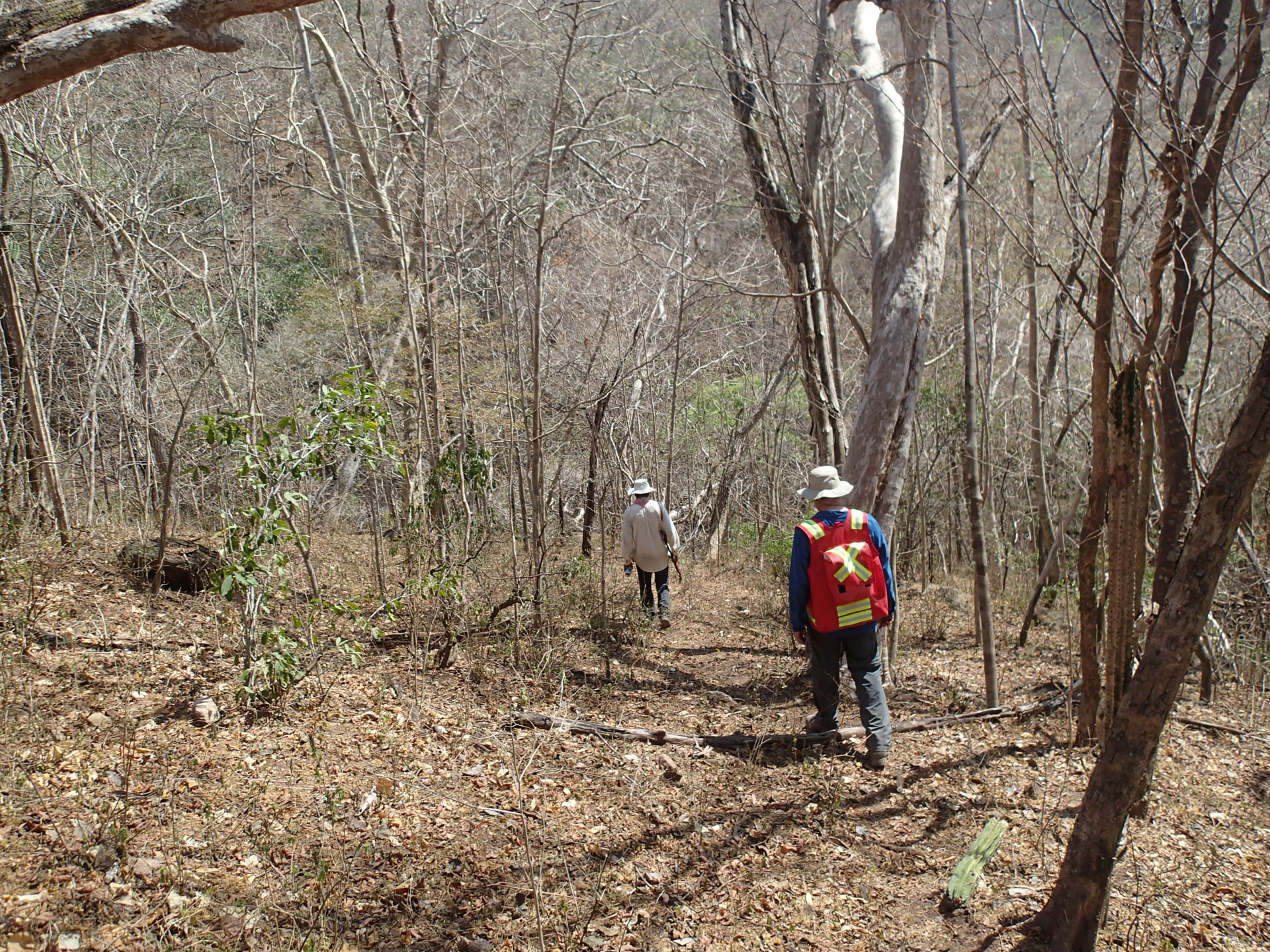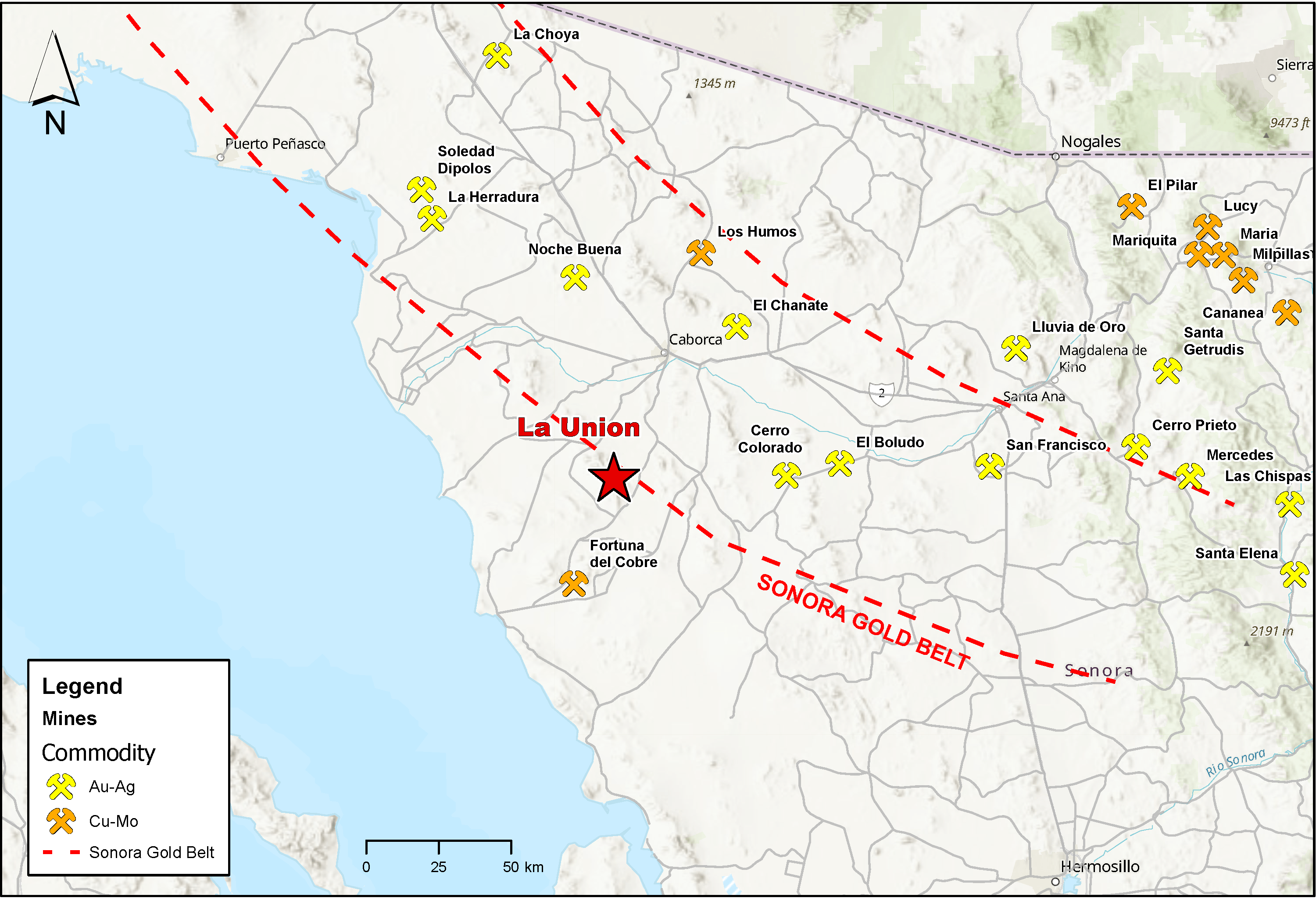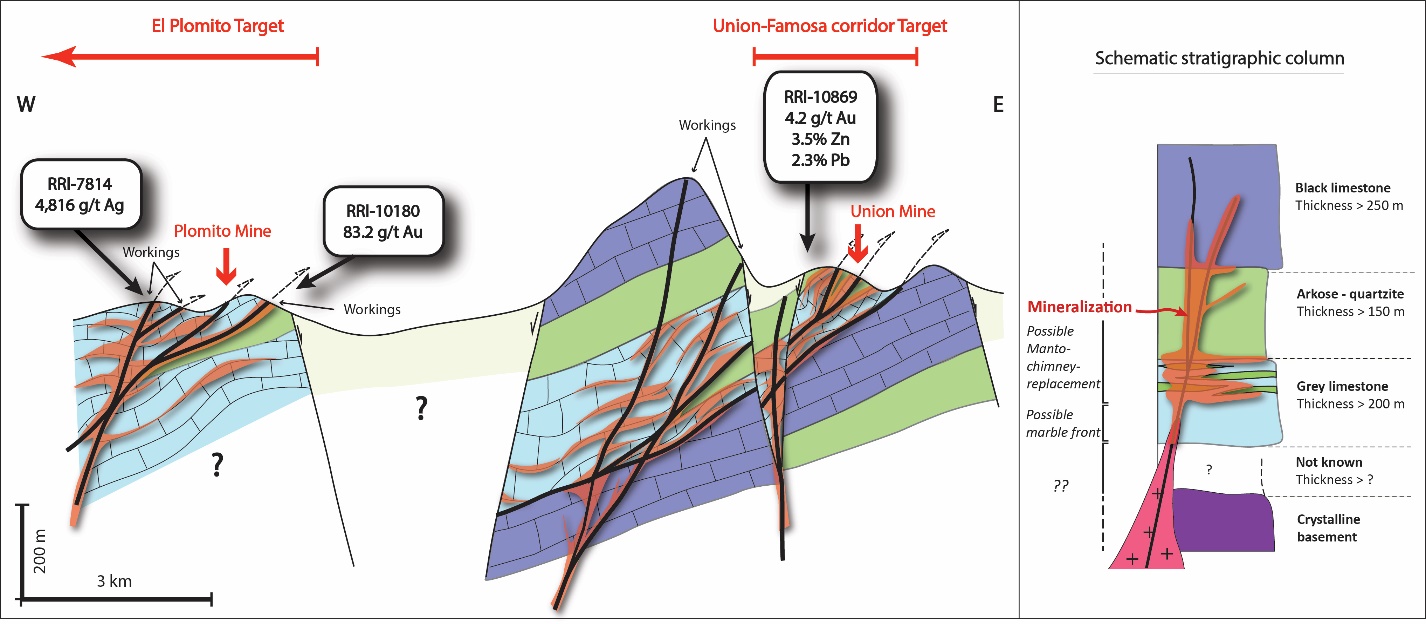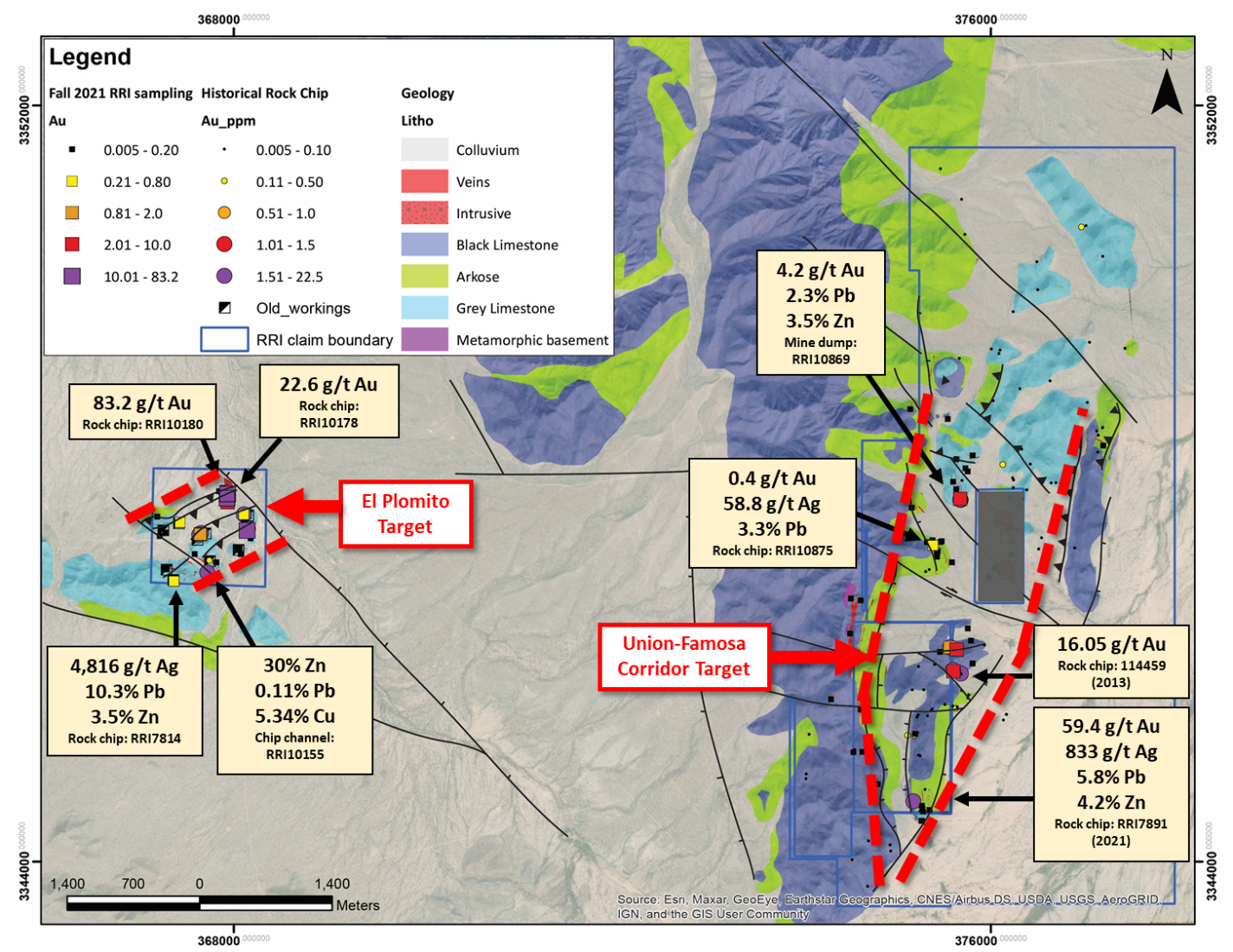OVERVIEW
| Commodity: | Polymetallic – Au, Ag, Pb, Zn, Cu |
| Deposit Type: | Manto-Chimney, Polymetallic system |
| Location: | Sonora, Mexico |
| Size: | 2,604 hectares |
| Status: | Available for Option |
La Union Project is located in westerns Sonora approximately 30 km south of Caborca part of the orogenic gold trend and is within close proximity of major mines such as: Noche Buena, La Herradura and Cerro Colorado. La Union has only seen small-scale production dating back to the 1950s by Peñoles and local families. The Project has since been left unexplored until 2012, when Paget and Millrock started exploration work. High-grade rock chip samples taken by Paget and Millrock triggered Riverside’s attention to the project and in 2019, Riverside purchased the project as part of a five Mexico project portfolio acquisition.
Riverside has since worked on expanding its current footprint at the La Union Project evaluating the existing system of mineralization and its potential and has received over $500,000 in funding from Hochschild Mining in 2022 for work and payments. October 2021 highlighted the high-grade gold mineralization (up to 59.8 g/t), Ag (833 g/t), Pb (5.8%), Zn (4.2%) in samples helping the Company better characterize the size of the system.
Figure 1: Location of La Union project within the gold belt of Sonora
RIVERSIDE EXPLORATION WORK
Riverside’s initial field work in September 2021 included selective rock sampling from abandoned mine workings and dumps with results returning up to 59.4 g/t Au and 833 g/t Ag (see Table 2). Further exploration work will begin shortly as the Company has completed its review.
La Union Polymetallic Project was previously defined as a manto-chimney style deposit that could potentially be linked to a porphyry-skarn system further at depth. The ongoing work has been demonstrating significantly high-grades in gold, silver, lead and zinc across mineralized areas. Near surface, the oxide gossan cap and carbonate replacement bodies are particularly extensive with strong similarities with the Leadville polymetallic system in Colorado, USA. At La Union the Paleozoic carbonate stratigraphic section is a composite of over 1,000 m thick regionally and the mineralization of chimneys and mantos is unexplored.
After completing a claim consolidation in September, Riverside conducted a follow up field mapping and sampling program of 103 samples with the best sample returning 83.2 g/t (2.6 oz/t) gold and 4,816 g/t (150 oz/t) silver. The work further enhanced Riverside’s understanding of the structural and lithological context by linking the small historical workings into a larger regional context. Although the Project is still in its initial stages, mineralization appears to be of manto-chimney and replacement type within Pre-Cambrian to Cambrian sedimentary rocks (see Figure 3 in Diagrams).
Following-up on this high-grade discovery Riverside’s team returned and was able to define the extent of the mineralization. The highlights of this latest work defined high grade polymetallic samples up to 30% Zn, 83.2 g/t Au, 4,816 g/t Ag, 10.3% Pb (see Table 1). Of the 103 samples assay value ranged from 83.3 g/t gold to non-detectable with about 30% of the samples returning significant values in gold, silver, lead and/or zinc the best being.
- Au – high: 83.2 g/t; low cut-off: 0.5 g/t
- Ag – high: 4,816 g/t; low cut-off: 300 g/t
- Pb – high: 10.3%; low cut-off: 0.1%
- Zn – high: 30%*; low cut-off: 0.1%
*30% Zn is the upper detection limit in analysis method performed
Table 1: Assays from La Union Polymetallic Project. Results from November 2021 program
| Sample ID | Au (g/t) | Ag (g/t) | Pb (%) | Zn (%) | Sample Type | Width_m | Description |
| RRI-10180 | 83.2 | 1.1 | - | - | chips | oxide veining | |
| RRI-10178 | 22.6 | 20.3 | - | - | dump | oxide veining | |
| RRI-7814 | 0.3 | 4816 | 10.3 | 3.5 | chips | oxide veining | |
| RRI-10155 | 0.0 | 14.7 | 1.1 | 30 | dump | hanging wall copper oxides | |
| RRI-10156 | 0.0 | 8.2 | 2 | 21.4 | chips | gossan | |
| RRI-10157 | 0.1 | 176 | 3.8 | 19.8 | chips | carbonate replacement | |
| RRI-10865 | 9.4 | 107.6 | 0.06 | 1.6 | chip channel | 0.8 | oxides |
| RRI-10866 | 9.9 | 53.6 | 0.01 | 2.5 | chip channel | 1.6 | brecciation with oxides |
| RRI-10888 | 3.6 | 373 | 7.3 | 7.3 | chip channel | 0.6 | manto with copper oxides |
| RRI-10889 | 2.6 | 169.7 | 0.7 | 6.6 | chip channel | 1.5 | brecciation with oxides |
| RRI-10869 | 4.2 | 42 | 2.3 | 3.5 | dump | brecciation with oxides | |
| RRI-10189 | 6.1 | 23.4 | 8.2 | 0.06 | chips | oxide veining | |
| RRI-7808 | 8.8 | 183.2 | 3.9 | 3.4 | chips | oxide veining |
Note: Best 13 assays from 103 samples collected.
Table 2: Sample Results from La Union Polymetallic Project (October 2021).
| Sample ID | Au (g/t) | Ag (g/t) | Pb (%) | Zn (%) | Cu (%) | Type | Description |
| RRI-7891 | 59.4 | 833 | 5.76 | 4.16 | 0.3 | rock chip | massive sulfide - dolomitic breccia |
| RRI-7895 | 40 | 3.3 | 0.13 | mine dump | massive sulfide and jasperoid | ||
| RRI-7894 | 8.3 | 239 | 0.17 | mine dump | jesperoid | ||
| RRI-7890 | 1.367 | 50 | 1.63 | 1.43 | mine dump | sulfide-oxide bearing breccia | |
| RRI-7893 | 0.473 | 12.4 | rock chip | brecciated contact - dolmite/quartzite | |||
| RRI-7889 | 0.072 | 76.4 | rock chip | brecciated contact - dolmite/limestone |
Note: Six of the higher-grade due diligence samples out of eight total are shown in Table 2.
GEOLOGY
Mineralization is primarily located within the Paleozoic sedimentary sequence, known in this area for reaching up to 1,000 m in thickness and host to multiple historical mines. Regionally the mountain range is characterized by alternating limestone, dolomite and quartzite; regionally contact mineralization has been observed to grow into a manto-chimney style deposits. These types of deposits tend to have higher metal grades, making this style of deposition attractive for exploration.
The La Union Project is part of the El Viejo Mountain range of NW Sonora, Mexico. The Sierra El Viejo comprises a thick sequence of Pre-Cambrian to Cambrian sedimentary units which the Company has been carefully mapping in detail. Many historical workings are spread across the range with the most extensive being the Union Mine, La Famosa Mine and El Plomito Mine; all located along the southern tip of the El Viejo range within Riverside’s mineral concessions.
Three sedimentary units have been identified from top to bottom: black limestone, quartzite, and grey limestone. Thicknesses of these units vary from 150 to 250 m with folding occurring mostly within the grey limestone, which is believed to be the primary reactive layer responsible for mineral deposition (see Figure 4 in Diagrams). As a weaker unit the grey limestone is prone to low angle thrusting while the quartzite units are more brittle and tend to fracture.
Post-mineral faulting also plays an important role. The west side of the property at the Plomito mine target area is separated from the Union-Famosa corridor target by a 3 km-wide colluvium-filled N-S trending graben. The geology at the Plomito Mine shows many similarities to the eastern side of the range at Union-Famosa where grey limestone with a small window of quartzite is mapped. Low angle faulting is also present in the area and tends to be mineralized showing carbonate replacement and patchy marble zones. Historical workings are scattered across the property and tend to follow the low angle oxidized structures varying from centimeters to metres in width.
Geochemistry shows an overall similar pattern across the property, with the dominant geochemical signature being polymetallic Pb-Ag-Zn-As-Cu-Sb-Au. Secondary Au-As association is recognized which suggests another hydrothermal event spatially associated with the dominant polymetallic event.
Mineralization is found on surface associated with low angle faults, folds, with the thicker mineralized intervals being where high angle fault intersect with other structures creating ‘traps’. GIS compilation of Riverside’s work and older data is showing a tendency for thicker mineralized zones to occur within the stratigraphy defined ‘grey limestone’ (see Figures 3 & 4 in Diagrams) where replacement and crack infilling is noted.
Riverside is currently planning future exploration work, which will include a geophysical survey to better identify the depth and behavior of mineralization within the grey limestone unit and the structural nature of the lower part of the sedimentary sequence. The next stage in exploration will be to compile the proposed geophysics with the existing information to identify drill targets for a 2022 program.
PREVIOUS WORK
Local historical productions in the 1950’s mined high-grade material averaging 7-20 g/t Au, 300 g/t Ag, 10-20% Pb and 5% Zn, for which mineralized bodies were traced for at least 80 m depth within oxides (Yantis, 1957). Since then, only small exploration programs have occurred including more recent work by Paget Mineral Exploration Company and Millrock Resources with sampling programs yielding up to 22.5 g/t Au and multiple high-grade polymetallic samples over the project area. The presence of many high-grade areas in addition to the thickness of the host rock and extent of the system across multiple known historic mines suggests an extensive system exits in this district.
DIAGRAMS
Figure 2: Map of Riverside’s La Union Polymetallic Project, Sonora, Mexico. Highlights of the results in October 2021 from rock sampling from Riverside
Figure 3: Interpretative schematic cross section of the Plomito target in the Union-Famosa corridor showing stratigraphic column with interpretative mineralization relationship.
Figure 4: Geological map of the Union Project highlighting the two zones of El Plomito and the Union-Famosa Corridor.
QUALIFIED PERSON, QA/QC & TECHNICAL DISCLOSURES
The scientific and technical data contained in this news release pertaining to the La Union Project was reviewed and approved by Freeman Smith, P.Geo, a non-independent qualified person to Riverside Resources, who is responsible for ensuring that the geologic information provided in this news release is accurate and who acts as a “qualified person” under National Instrument 43-101 Standards of Disclosure for Mineral Projects.
Rock samples from the exploration program discussed above at La Union were taken to the Bureau Veritas Laboratories in Hermosillo, Mexico for fire assaying for gold. The rejects remained with Bureau Veritas in Mexico while the pulps were transported to Bureau Veritas laboratory in Vancouver, BC, Canada for 45 element ICP/ES-MS analysis. A QA/QC program was implemented as part of the sampling procedures for the exploration program. Standard samples were randomly inserted into the sample stream prior to being sent to the laboratory.







